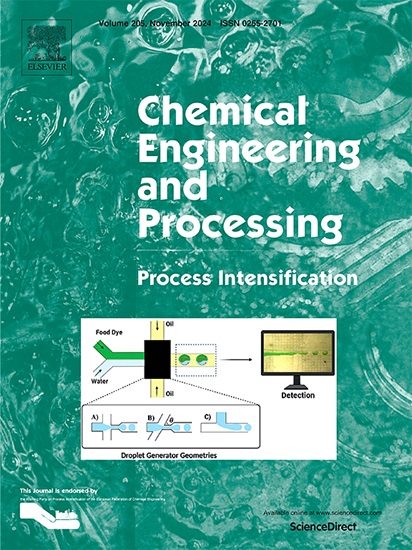Oily wastewater treatment via a visible-light-responsive slurry membrane photocatalytic reactor incorporating Bi2WO6-based photocatalysts
IF 3.8
3区 工程技术
Q3 ENERGY & FUELS
Chemical Engineering and Processing - Process Intensification
Pub Date : 2025-05-16
DOI:10.1016/j.cep.2025.110365
引用次数: 0
Abstract
This study focuses on the development and integration of Bi₂WO₆-based visible-light-responsive photocatalysts with a zirconia/alumina ultrafiltration membrane in a slurry photocatalytic ceramic membrane reactor (SPCMR) for oily wastewater treatment, highlighting the synergistic effect of combining photocatalysis with membrane separation. To this end, several visible-light-active photocatalysts, including NH₂-MIL-125(Ti)/Bi₂WO₆, WO₃/Bi₂WO₆, and Bi₂O₃/Bi₂WO₆, were synthesized via hydrothermal methods and characterized using X-ray diffraction (XRD), Fourier-transform infrared spectroscopy (FTIR), scanning electron microscopy (SEM), and nitrogen adsorption–desorption analyses. The filtration performance of the system was evaluated under varying oil concentrations ranging from 1000 to 3000 ppm, at natural pH, with a photocatalyst dosage of 1 g/L over a 4-hour operational period. Removal efficiency was assessed based on total organic carbon (TOC) content. Results showed that membrane performance declined at higher concentrations (3000 ppm) due to surface fouling; however, this limitation was mitigated by incorporating the SPCMR system. TOC removal varied depending on parameters such as transmembrane pressure (TMP), flow rate, and light intensity. Among the tested photocatalysts, NH₂-MIL-125(Ti)/Bi₂WO₆ exhibited the highest efficiency, achieving up to 92% TOC removal. These findings highlight the potential of Bi₂WO₆-based composite photocatalysts in SPCMR systems as a promising approach for sustainable oily wastewater remediation.
采用含bi2wo6基光催化剂的可见光响应浆状膜光催化反应器处理含油废水
本研究重点研究了在浆状光催化陶瓷膜反应器(SPCMR)中开发并集成基于Bi₂WO₆的可见光响应光催化剂与氧化锆/氧化铝超滤膜,用于含油废水的处理,突出了光催化与膜分离相结合的协同效应。为此,采用水热法合成了NH₂-MIL-125(Ti)/Bi₂WO₆、WO₃/Bi₂WO₆和Bi₂O₃/Bi₂WO₆等几种可见光活性光催化剂,并利用x射线衍射(XRD)、傅里叶变换红外光谱(FTIR)、扫描电镜(SEM)和氮吸附-解吸分析对其进行了表征。在自然pH值为1000 ~ 3000 ppm、光催化剂用量为1 g/L、运行时间为4小时的条件下,对该系统的过滤性能进行了评估。以总有机碳(TOC)含量评价去除率。结果表明,在高浓度(3000 ppm)下,由于表面污染,膜性能下降;然而,通过合并SPCMR系统,这一限制得到了缓解。TOC去除率的变化取决于诸如跨膜压力(TMP)、流速和光照强度等参数。在所测试的光催化剂中,NH₂-MIL-125(Ti)/Bi₂WO₆的去除率最高,达到92%。这些发现突出了Bi₂WO₆复合光催化剂在spmr体系中的潜力,是一种有前景的可持续含油废水修复方法。
本文章由计算机程序翻译,如有差异,请以英文原文为准。
求助全文
约1分钟内获得全文
求助全文
来源期刊
CiteScore
7.80
自引率
9.30%
发文量
408
审稿时长
49 days
期刊介绍:
Chemical Engineering and Processing: Process Intensification is intended for practicing researchers in industry and academia, working in the field of Process Engineering and related to the subject of Process Intensification.Articles published in the Journal demonstrate how novel discoveries, developments and theories in the field of Process Engineering and in particular Process Intensification may be used for analysis and design of innovative equipment and processing methods with substantially improved sustainability, efficiency and environmental performance.

 求助内容:
求助内容: 应助结果提醒方式:
应助结果提醒方式:


